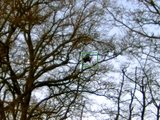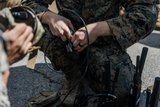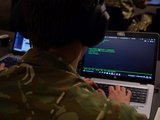Elbit Systems unveils newest addition to Dominator IICS family
Elbit Systems has launched the newest member of its Dominator Integrated Infantry Combat System (IICS) solution family, the Dominator-Light Dismounted (LD). The lightweight version is designed specifically for the tactical dismounted infantry soldier and special forces.
Dominator-LD is a soldier centric solution, designed as a command and control (C2) solution for the individual soldier level that complements the command level Dominator IICS.
Enabling full situational awareness via network-integrated information systems, the system provides advanced mobility due to its reduced size, weight and power (SWaP). It is comprised of Elbit Systems' RAPTOR rugged, all-in-one wearable computing unit, the TORC2H –D command and control application and the Tadiran PNR-1000A, a compact, lightweight, personal network radio. An add-on capability for a comprehensive on-the-move situational awareness picture is also available in the JS Eyepiece handheld display unit.
The new system includes a load cartridge system for the fighting soldier, and has a modular design, enabling a small number of components to be configured in the field in various ensembles, to support different operational needs. Dominator-LD weighs less than 1kg for over 24 hours of operational use.
According to the company, when outfitted with Dominator-LD, ‘soldiers can send and receive information in real-time, view an up-to-the-minute common operational picture, access live videos from either external or on-body sensors and transmit images and positions back to the command post and colleagues’.
The system’s modular design and open architecture also enables growth potential through integration with Battle Management System (such as Elbit's TORC2H) and coalition forces as well as with all of the Dominator IICS systems and sub-systems; including the Skylark I-LE Unmanned Aircraft Systems (UAS), the Mars un-cooled thermal imaging camera, the Coral thermal imaging camera, and the S-NAV soldier navigating system.
More from Digital Battlespace
-
![Chess Dynamics successfully demonstrates Vision4ce AI-driven tracker]()
Chess Dynamics successfully demonstrates Vision4ce AI-driven tracker
The Vision4ce Deep Embedded Feature Tracking (DEFT) technology software is designed to process video and images by blending traditional computer vision with artificial intelligence (AI) algorithms to present actionable information from complex environments.
-
![Wave Relay devices cleared for security use on commercial systems in industry trend]()
Wave Relay devices cleared for security use on commercial systems in industry trend
Persistent Systems has been cleared by National Security Agency (NSA) to transmit sensitive data on commercial networks. The devices are added to the NSA’s Commercial Solutions for Classified (CSfC) component list which also includes other companies’ products providing the same security.
-
![UK teases cyber spending boost in Strategic Defence Review ahead of “imminent” release]()
UK teases cyber spending boost in Strategic Defence Review ahead of “imminent” release
The release of the UK’s Strategic Defence Review (SDR) has been long promised as mid-year. It is possible it could be as early as 2 June although the UK Ministry of Defence (MoD) continues to play its cards close to its chest.
-
![Intelsat emphasises SATCOM resilience for SOF in contested domains (video)]()
Intelsat emphasises SATCOM resilience for SOF in contested domains (video)
Intelsat outlines how its multi-orbit SATCOM architecture is enhancing connectivity and resilience for special operations forces operating in degraded and contested environments.
-
![US Space Force’s next-generation missile warning system moves forward with $500 million in new contracts]()
US Space Force’s next-generation missile warning system moves forward with $500 million in new contracts
Next-Generation Overhead Persistent Infrared (Next-Gen OPIR) satellites are intended to provide early warning of missile launches from any location worldwide and new ground stations will result in expanded coverage of critical missile warning.























